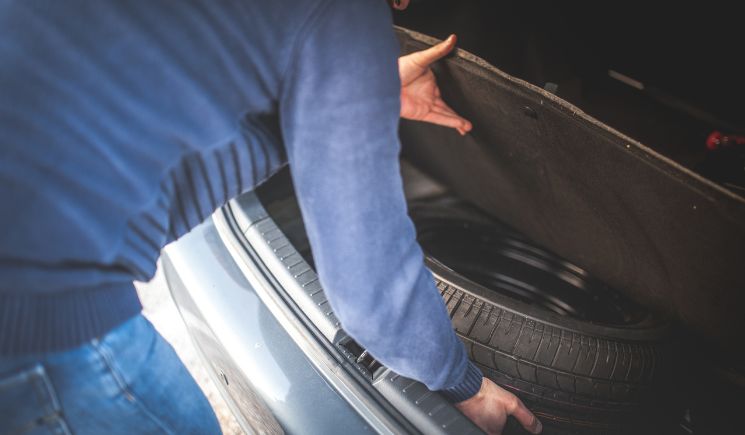Water In Trunk Under Spare Tire

Water conservation is an important topic that all drivers should be aware of. One area of concern for car owners, in particular, is the potential for water to accumulate and become trapped inside a car’s trunk – specifically under the spare tire. This article will provide insight into what can happen when water accumulates beneath a vehicle’s spare tire and how drivers can prevent it from occurring.
When water becomes trapped beneath the spare tire in a vehicle’s trunk, it can lead to rusting, corrosion and other damage if left unattended over time. Drivers must pay attention to this potentially hazardous issue in order to maintain their cars’ safety and longevity. By being mindful of our actions, we can make sure that no needless harm comes to our vehicles due to poor maintenance habits or lack of awareness surrounding this issue.
Table of Contents
- Causes Of Water In The Trunk
- Preventing Water From Entering The Trunk
- Damage Caused By Water In The Trunk
- Fixing Water Leaks In The Trunk
- Cleaning Up Water In The Trunk
- Frequently Asked Questions
- Conclusion
Causes Of Water In The Trunk
A common cause of water in the trunk under the spare tire is from an overflowing rain gutter or downspout on the roof that isn’t draining correctly. If there are any holes or weaknesses in the seal around the sunroof where water has been able to enter between it and the car body, then this could also lead to flooding in the trunk area. Lastly, if there is excessive condensation buildup near the tailpipe due to too much moisture outside, then this might find its way into your vehicle as well.
Luckily, these issues can all be addressed with preventative measures such as making sure gutters are clear of debris so they don’t overflow; sealing up any gaps in seals around windows, doors and sunroofs; and parking away from highly humid areas whenever possible. Taking these steps now should save you time and money later when dealing with unwanted pooling of liquid in your vehicle’s corners. Moving ahead, let’s look at some additional ways we can keep our trunks dry…
Preventing Water From Entering The Trunk
Water entering the trunk of a car can be an inconvenient, yet preventable problem. As it has been noted previously, water in the trunk is often caused by blocked drains or holes that allow for leakage during rainstorms and other wet weather conditions. To avoid such issues, there are certain steps one must take to ensure that their trunk remains dry:
- Regularly check the seals around your vehicle’s windows, doors, and sunroofs. This helps keep moisture outside where it belongs.
- Make sure all gutters on your home or building are free of debris so that they can properly redirect runoff from heavy rains away from your vehicle.
- Clean out any dirt or leaves from drain tubes leading to and under your car. If these become clogged with debris, water will have nowhere else to go but into the interior of your car through its leaked points.
- Consider installing covers over sunroofs if you don’t use them regularly; this offers extra protection against potential leaks due to storms or high winds.
- Inspect regularly for any signs of corrosion around door frames or near window seals – corroded metal can quickly cause major water damage when exposed to excessive moisture levels.
By taking these simple measures to protect your vehicle from excess moisture buildup, you will not only help preserve its longevity and condition but also reduce the risk of incurring expensive repair costs down the line. With that said though, even with proper prevention methods in place, sometimes water may still enter a vehicle’s trunk area due to unforeseen circumstances—such as faulty construction materials or extreme weather conditions—which leads us now onto discussing how best to mitigate the damages resulting from such occurrences.
Damage Caused By Water In The Trunk
It was a sunny day in the desert, and I had been driving for hours on my way to inspect an area of water conservation. As I drove down the highway, I noticed something out of place – there was a large puddle of water gathering under the spare tire in the trunk of my car. It seemed strange that it would be there since nothing had been spilled or left behind, so I decided to investigate further.
When I opened up the trunk, I realized what had happened: there were several small leaks coming from all around the edges where two pieces fit together. The liquid slowly pooled at the bottom until it reached a critical point and started spilling over into surrounding areas. This problem could cause extensive damage if left unchecked; not only would it eventually create rust spots on any metal parts inside, but it could also lead to mold growth within any organic materials such as carpeting or fabric lining.
| Damage Type | Description | Prevention/Solution |
|---|---|---|
| Rust | Metal corrodes due to oxidation when exposed to moisture | Make sure all metal surfaces are dry and clean before storage Use wax or sealant products to protect against rusting |
| Mold | Organic material decays due to fungal growth caused by high humidity levels | Place desiccants (such as silica gel) near affected areas Ventilate enclosed spaces regularly Clean affected materials with bleach solution once discovered |
To protect your vehicle from these kinds of damages, regular inspection for signs of leaking is necessary. Regularly check for wet spots after rainy days or snow storms; even small amounts can add up quickly if left unattended! Taking preventive measures now will help avoid costly repairs later on down the road. With proper maintenance and care, you can keep your car safe from water-related damage and enjoy its use for years to come.
Fixing Water Leaks In The Trunk
As we have seen, water in the trunk is a serious problem that can cause major damage to your car. But there are steps you can take to fix it. The first step is finding out where the leak is coming from and sealing off any cracks or gaps. If the source of the water isn’t obvious, then look for signs of rust along door seals and other areas around the trunk. This will indicate where water may be seeping in.
If you find an area that needs repair, such as old weatherstripping or corroded metal, replace them with fresh materials to prevent further leakage into your trunk. Check all seals and gaskets to ensure they are properly sealed against moisture before reattaching them. You may also want to consider using waterproof sealant on vulnerable areas like window frames or doorsills if necessary.
Once these repairs have been made, check for leaks again by filling up a bucket with water and pouring it over different parts of your car’s exterior near the trunk area. If no more water enters the trunk, you’ve successfully stopped the leak! Now you’re ready to move onto cleaning up any existing mess caused by previous water intrusion in order to restore its original condition.
Cleaning Up Water In The Trunk
Removing water from the trunk of your vehicle can be a tricky process, requiring both caution and care. First things first: you’ll need to find out where exactly the water is coming from. If it’s raining outside, check for any holes or gaps in the seals around the windows and door frames that could be allowing moisture into the car. Make sure there are no broken hoses or leaks in nearby components like radiators or washer fluid tanks. Once you know what caused the problem, take steps to address it right away.
If you’re dealing with an accumulation of standing water inside your trunk, use towels or rags to soak up as much liquid as possible before attempting to move on to other methods. Be careful not to create too much suction when drying–you don’t want to cause further damage by sucking debris into delicate electronics! You may also want to place a few large containers under each corner of the spare tire well; this will help keep all unwanted liquids contained until they can be properly disposed of later on.
The next step is ventilation: open doors and windows whenever possible (and safe) and turn on fans if available. This will allow air circulation which should help evaporate most remaining moisture in due time. In addition, make sure to remove any items stored in the trunk that have been affected by the presence of water–they won’t dry out effectively while still inside the car’s interior. Taking these simple precautions should prevent future occurrences of water buildup beneath your spare tire and protect your vehicle from lasting harm due to excess moisture exposure.
Frequently Asked Questions
How Can I Tell If There Is Water In My Trunk?
Do you think there is water in your trunk? You may not be sure, but the tell-tale signs are easy to spot! As a water conservation specialist I can assure you that if there is any suspicious moisture lurking beneath the spare tire it’s time for some investigation. A figure of speech comes to mind – ‘as still as a pond’ – this implies that even when no visible liquid is present, one must explore further. There could be dampness or corrosion indicative of water presence and should not be overlooked. So take the necessary precautions and check under the hood today!
What Are The Signs Of Water Damage In The Trunk?
As a water conservation specialist, it is important to be aware of the signs of water damage in your vehicle’s trunk. Water can cause irreparable harm if left unchecked for too long. The most common indicators that you may have an issue include mold and mildew growth, rusting metal components, warped interior panels or carpeting, as well as a musty odor emanating from the area. If any of these are present, further investigation is necessary to determine the source and extent of the problem.
What Is The Best Way To Seal The Trunk Against Water Intrusion?
Sealing the trunk of a car against water intrusion is like ‘plugging a dike’: it’s essential to prevent further damage and destruction. To effectively do this, start by removing any interior trim panels that may be in place. Then, use an appropriate sealing product such as silicone caulk or expanding foam sealant to create a barrier between the inside and outside of the trunk. Make sure there are no gaps or openings left unsealed; even small cracks can allow water to seep through. Once all areas have been sealed properly, you can rest assured that your vehicle is safe from any potential water-related issues moving forward!
What Should I Do If I Find Water In The Trunk?
If you find water in the trunk, it’s important to act quickly. Water can cause considerable damage if left unchecked, so make sure you identify and fix any sources of leakage right away. Inspect all seals around windows, doors, and other openings for signs of wear or damage. You may also need to replace weatherstripping or use a sealant to block out moisture. Finally, check under the spare tire for any pools of standing water that could be seeping into the trunk area. Taking these steps will help ensure your car stays dry and safe from any long-term effects of water intrusion.
Are There Any Potential Health Risks From Water In The Trunk?
When it comes to water in the trunk, there are potential health risks that can’t be ignored. The most common risk is mold growth, which can occur when warm and moist areas such as a trunk remain undisturbed for an extended period of time. Additionally, if the water has been sitting long enough to become stagnant or contaminated with pollutants from the road, this could result in sickness upon contact with any exposed skin. It’s important to take action quickly and safely dispose of any standing water found in the trunk.
Conclusion
We must all work together to prevent water from entering our trunks. Sealing the trunk and checking it regularly is an important step in preventing potential damage. A staggering 75% of water intrusion cases are due to inadequate sealing around windows, doors, and other openings. As a result, I strongly urge everyone to take the necessary steps to ensure their vehicle’s trunk is sealed properly against any unwanted moisture.






